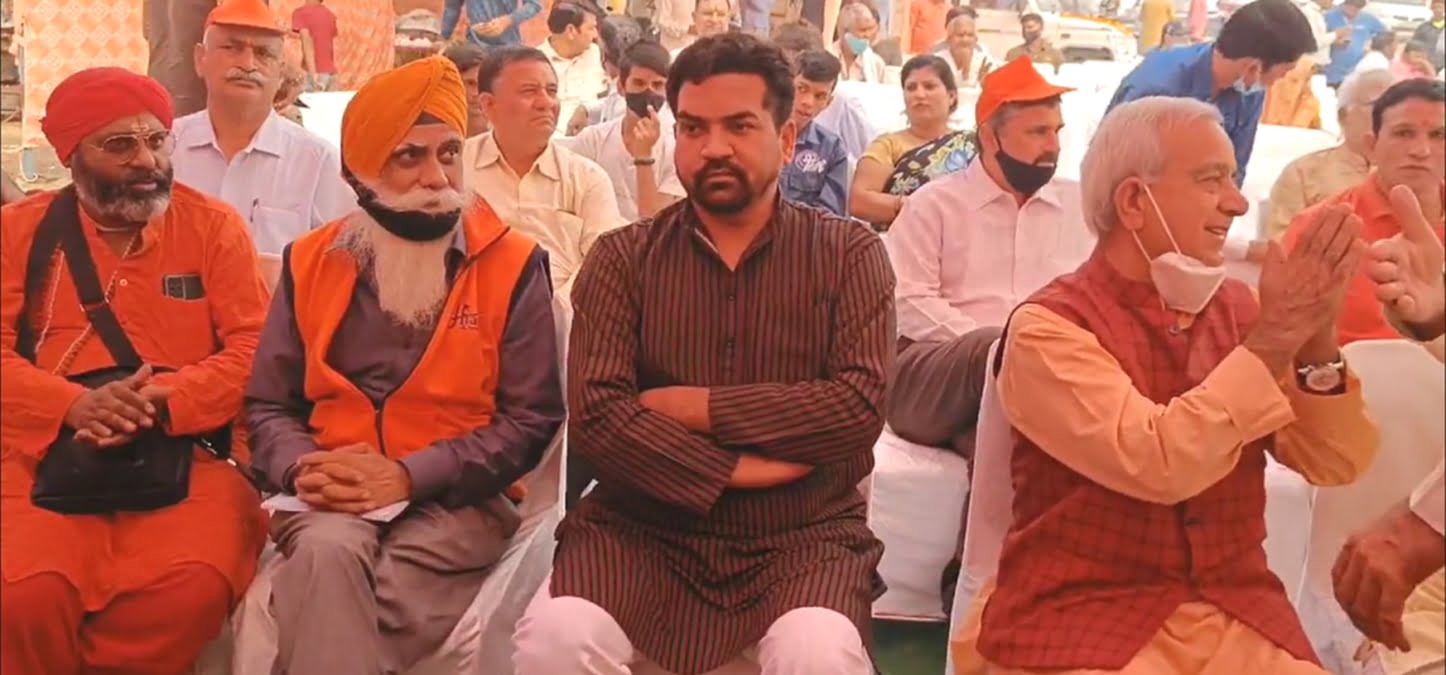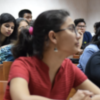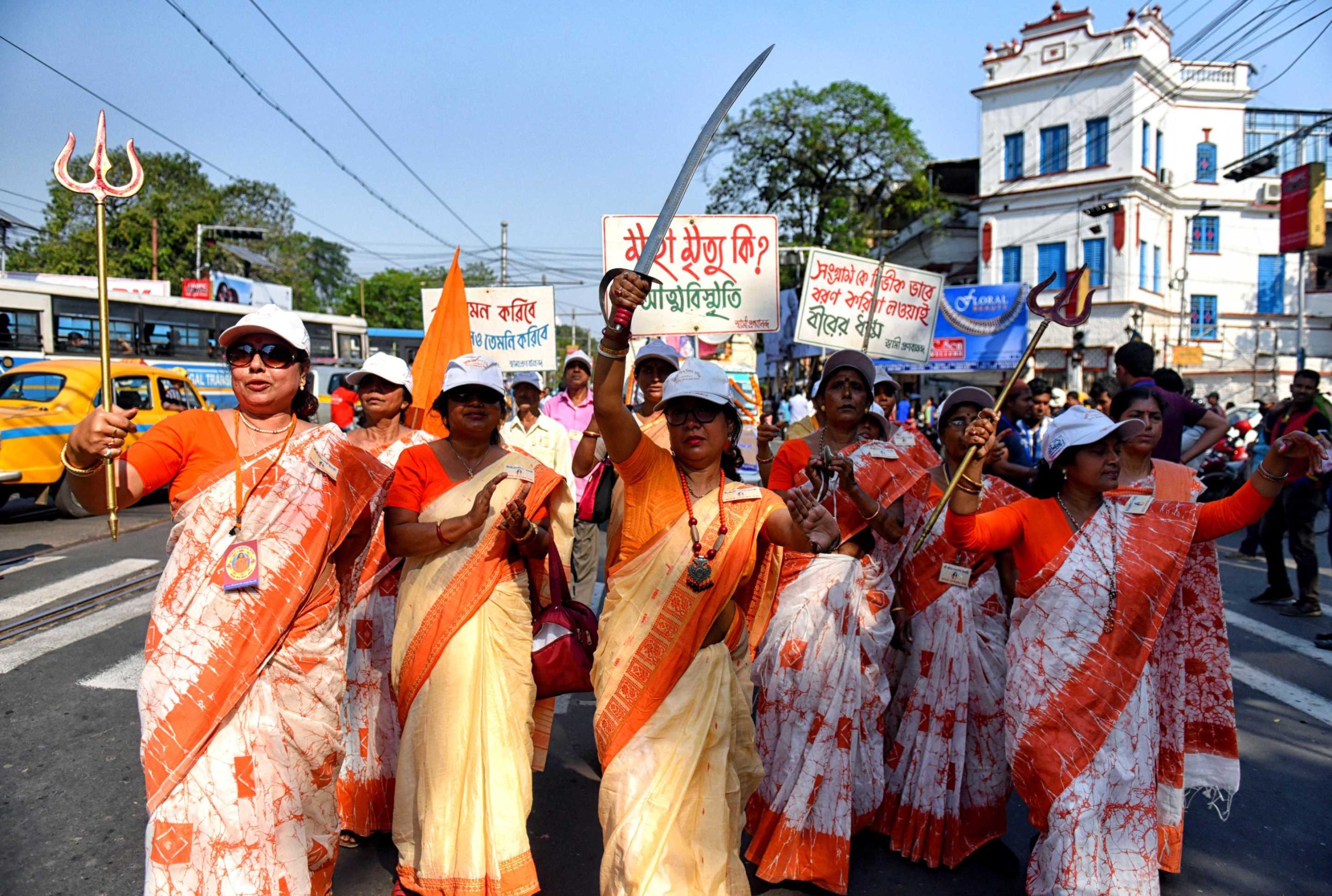In the final week of October, protesters, many from right-wing groups, tried to disrupt a Gurgaon site where Muslims were offering namaz. Dozens were arrested by the police and released on bail in less than 24 hours.
Members of Sanyukt Hindu Sangharsh Samiti organised a Govardhan puja on the same site a week later. Several protestors who had earlier been arrested were present. So was Kapil Mishra, a prominent BJP leader.
One of the slogans that the attendees chanted at the puja was “Desh ke gaddaron ko, goli maaro saalo ko.” (Shoot the country’s traitors). Amit Hindu, a member of Bajrang Dal, was among the chanters.
The slogan has been used a number of times to stage public opposition. The ‘anti-nationals’ alluded to in the phrase have almost always been Muslims, when not those who do not subscribe to the extremist Hindutva politics endorsed by the RSS and by extension, the BJP. Yet, any indication of Islamophobia in contemporary India is countered by a desperate public claim that reiterates the virulent threat that the increasing Muslim population poses to Indian Hindus and India at large. In fact, right-wing circles tend to configure Indian Hindus as a religious ‘minority’ in India, which enables them to exploit Islamophobic rhetoric under the guise of Hindutva nationalism.
Also read: From Lakhimpur Kheri To Aryan Khan: The Media Must Set Priorities Straight
The ‘anti-nationals’ alluded to in the phrase have almost always been Muslims, when not those who do not subscribe to the extremist Hindutva politics endorsed by the RSS and by extension, the BJP. Yet, any indication of Islamophobia in contemporary India is countered by a desperate public claim that reiterates the virulent threat that the increasing Muslim population poses to Indian Hindus and India at large. In fact, right-wing circles tend to configure Indian Hindus as a religious ‘minority’ in India, which enables them to exploit Islamophobic rhetoric under the guise of Hindutva nationalism.
In Gender, Space and Agency in India, Sara Smith’s chapter situates political governance of intimacy in Leh District. Smith recalls that in a 2007 interview, a senior member of the Ladakh Buddhist Association had mentioned that “keeping the district Buddhist” was their top priority. Buddhist political leaders actualised their goals by discouraging Buddhist women from using family planning to promote population growth in Leh. The politicisation of reproductive health of citizens was, therefore, made possible by the threat of Muslim domination.
Given the recurrence of questions on minority, a pertinent question is: Who constitutes a minority? The realities of caste politics and religious domination provide varying answers.
Caste demographics in India exhibit that the population comprises of 9% people belonging to Scheduled Tribes, 20% belonging to Dalits, and 41% belonging to Other Backward Class. The demographic majority is, then, constituted by people from structurally oppressed social backgrounds.
Demographics is consequently not a flawless parameter when seen in the context of caste in India. People belonging to ‘upper’ caste groups constitute the actual socialised majority because they preserve an ambiguous and oppressive caste system that denies opportunities of social assimilation and financial upliftment to people belonging to traditionally marginalised communities.
Muslim population in India amounts to around 14%. Data published by Ipsos exhibits that Indians overestimate the proportion of Muslim population in the country. Even if population count is momentarily ignored, the social realities of oppression remain the same: indeed, Muslims constitute a minority group because physical and symbolic violence against Muslims is habitualised and made socially acceptable under perceived threats to Hindu existence.
Also read: Call For Genocide Against Muslims, Police Apathy—Sanctioned By The Centre’s Extremism
The recent Govardhan puja in Gurgaon is a case in a point. In addition to the ‘performance’ of physical displacement of Muslims, the organisers and attendees repeatedly reinforced problematic vitriol directed against either Islam or Muslims.
For instance, Dinesh Bharti, a member of Bharat Mata Vahini, asserted that Islam, a monotheistic religion, doesn’t mention the birth-place of Allah whereas Hinduism, a polytheistic religion, mentions details — birth-place — pertaining to all deities that it worships. What Bharti intends to imply is not only Islam’s irrationality and illegitimacy as a religion, but also its epistemic inadequacy and subsequent inferiority.
On the subject of illegitimate occupation of roads in Gurgaon, Kapil Mishra proclaimed that Hindus, too, can populate public spaces if they want to, given the number of their daily pujas, yet they don’t. Mishra, thus, epitomises Hindu identity by emphasising its ontological supremacy. Essentially, his implication is that Hindus, who have a valid claim to social space, do not extend their claim in the way Muslims do. The pattern in the rhetoric of BJP and Sangh leaders remains the same.
How can expectations of adherence to morally prescribed norms of public behaviour be valid when their applicability is spatio-temporally and religiously divided? Mishra considers Muslim ‘occupation’ of Gurgaon roads for fifteen minutes of namaz unreasonable while in 2019, Yogi Adityanath closes UP schools to help Kanwariyas move unhindered as part of their annual yatras. Irrespective of the time and place of these developments, the structures that inform the politics of BJP and its leaders make it clear that the recent disruption of namaz in Gurgaon is not an isolated event.
How can expectations of adherence to morally prescribed norms of public behaviour be valid when their applicability is spatio-temporally and religiously divided? Mishra considers Muslim ‘occupation’ of Gurgaon roads for fifteen minutes of namaz unreasonable while in 2019 Yogi Adityanath closes UP schools to help Kanwariyas move unhindered as part of their annual yatras. Irrespective of the time and place of these developments, the structures that inform the politics of BJP and its leaders make it clear that the recent disruption of namaz in Gurgaon is not an isolated event.
A few weeks back, BJP MP Anantkumar Hegde wrote a letter to the MD and CEO of CEAT, invoking CEAT’s recent advertisement that features Aamir Khan’s appeal to the public to not burst crackers for public safety. Hegde asked the CEO to address the additional problem created by Muslim offering of namaz on roads on Fridays and festive days. He also cited how the loud noise emitted during Azan is a problem. His reactionary letter could even be seen as a desperate attempt to use satire to express his concern for Hindu sentiments.
In fact, BJP leaders continue to diagnose Hindu unrest and hurt sentiments at every available opportunity. The message is clear. Indians can either be Islamophobic or anti-national.
Featured image source: TheWire
About the author(s)
Mridula Sharma is a researcher and a writer. Her work lies in the intersection of feminist theory, postcolonial studies, and popular culture.





